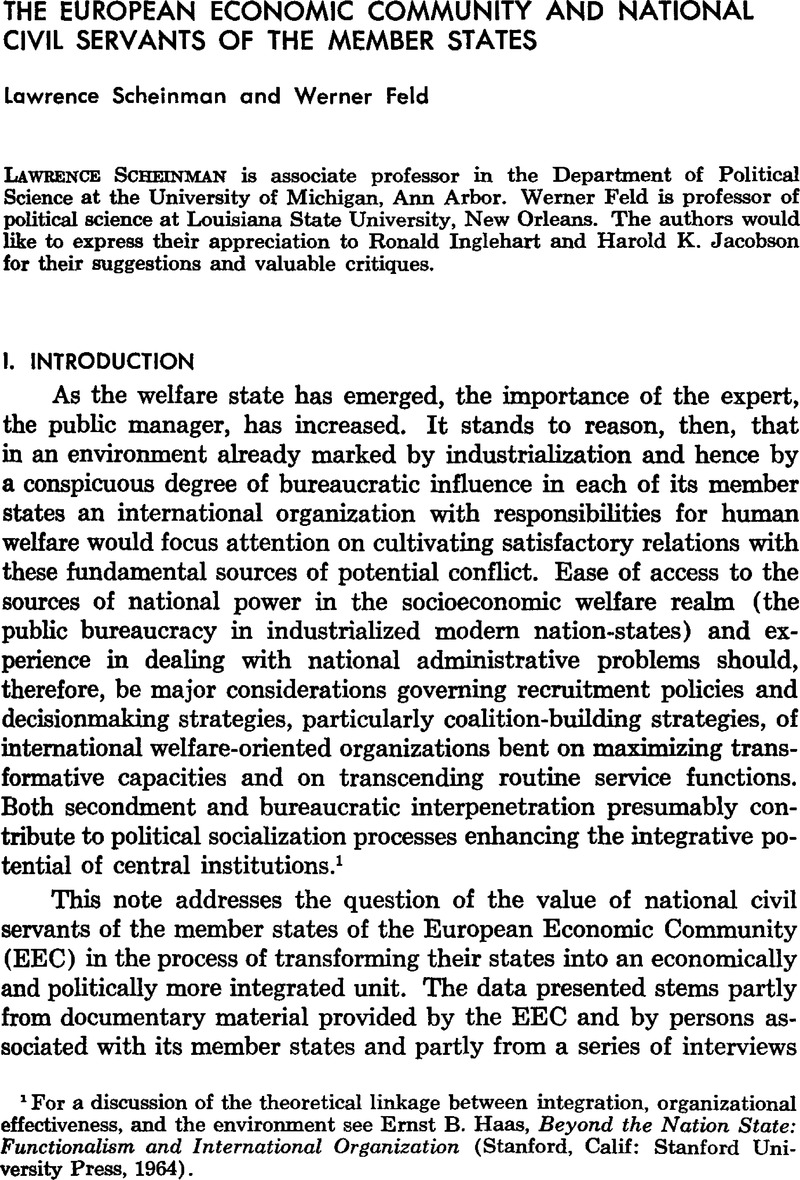Published online by Cambridge University Press: 22 May 2009

1 For a discussion of the theoretical linkage between integration, organizational effectiveness, and the environment see Haas, Ernst B., Beyond the Nation State: Functionalism and International Organization (Stanford, Calif: Stanford University Press, 1964).Google Scholar
2 Two of the national officials had been members of the eurocracy, two had been assigned to the permanent missions of their countries to the communities, and nineteen had had extended contact in the context of working group activities.
3 Lemaignen, Robert, L'Europe au berceau: Souvenirs d'un technocrate (Paris: Plon, 1964), pp. 71–72. Authors' translation.Google Scholar
4 Lindberg, Leon N., The Political Dynamics of European Economic Integration (Stanford, Calif: Stanford University Press, 1963), p. 55.Google Scholar
5 The share of ECSC officials drawn from national or international administrations was 44.46 percent in 1956; 39.39 percent was drawn from industry (mainly coal and steel) according to Jean E. Humblet, “Civil Service of the European Coal and Steel Community“ (Luxembourg). (Mimeographed.) Unfortunately Humblet did not always make clear whether he was referring to alli personnel of the ECSC or only those who were qualified as category A personnel.
6 See Spinelli, Altiero, The Eurocrats: Conflict and Crisis in the European Community, trans. Haines, C. Grove (Baltimore, Md: Johns Hopkins Press, 1966), p. 86.Google Scholar
7 Confirmed by the Italian respondents during the interviews in Rome.
8 “Who Are the 'Eurocrats'?” European Community, 04–05 1967 (No. 102), p. 8.Google Scholar
9 Fourteen of the 31 French officials who resigned from the commission in the period under investigation held the grade of A-4. This is the grade immediately below chef de division, the promotion to which has been characterized as a bottleneck in the pattern of EEC careers. A majority of these apparently did return to the French bureaucracy.
10 We have relatively little in the way of comparative data. The profiles of fourteen West German officials who held A-l through A-3 rank and who left the service of the EEC between 1962 and 1967 indicated that a higher proportion of German officials recruited on a seconded basis from Bonn or Laender administrations return to their former positions upon leaving the EEC. Ten of these fourteen officials were recruited from national administrations; eight of the ten returned, one retired, and the other went to private enterprise. Data on Italian turnover between 1962 and 1967 reveals that more than 50 percent of those who resigned from the commission went to the Italian administration. However, we do not have reliable data on their origins or on those of the remaining 50 percent who went to other nongovernmental positions.
11 See on this matter Lindberg, Leon N., “Political Integration as a Multidimensional Phenomenon Requiring Multivariate Measurement,” International Organization, Autumn 1970 (Vol. 24, No. 4), pp. 649–731.CrossRefGoogle Scholar